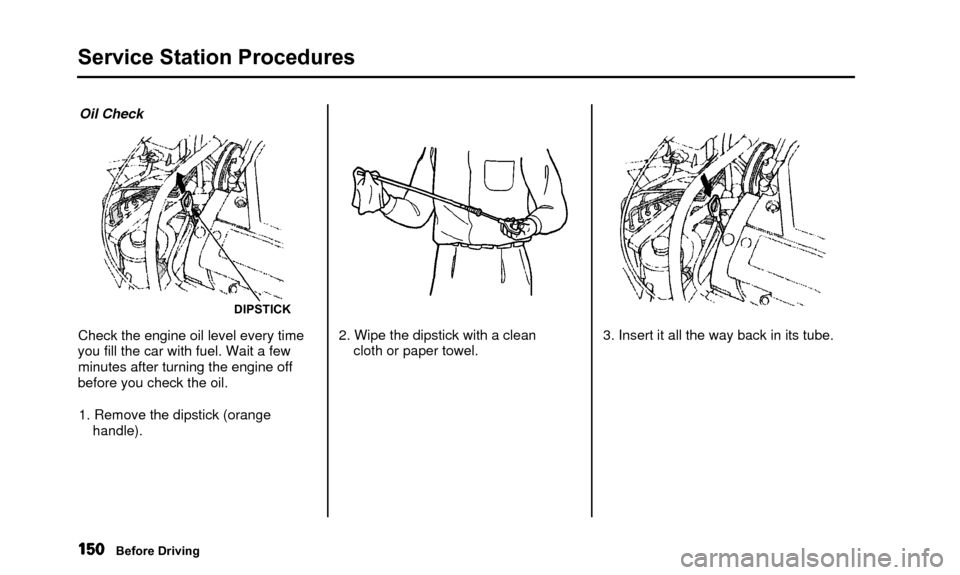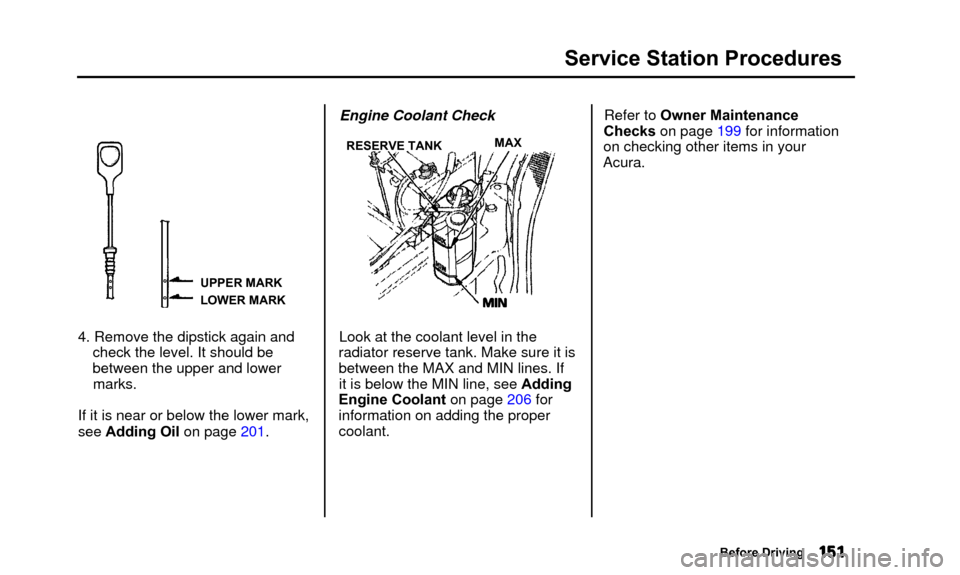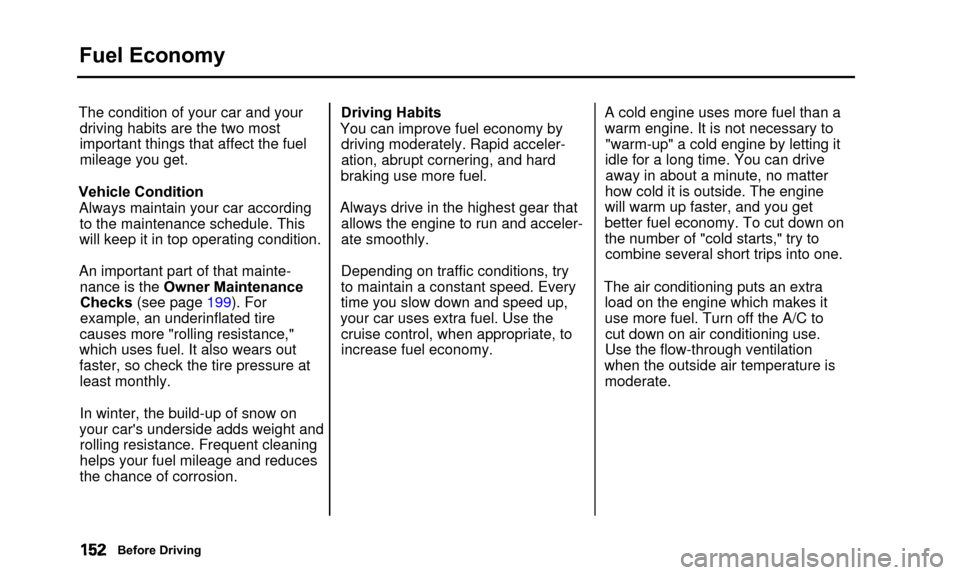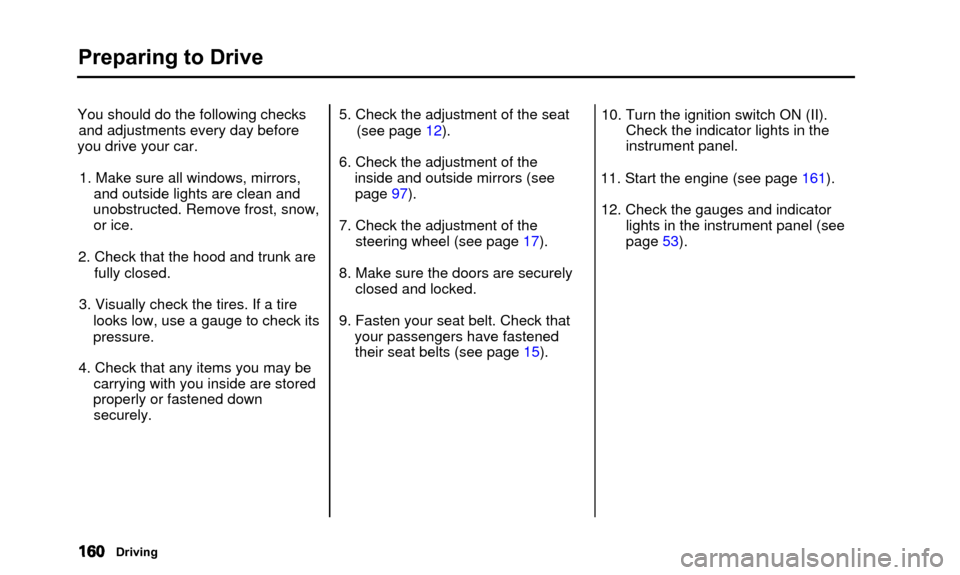engine Acura TL 2000 3.2 Owner's Guide
[x] Cancel search | Manufacturer: ACURA, Model Year: 2000, Model line: TL, Model: Acura TL 2000Pages: 311, PDF Size: 3.05 MB
Page 153 of 311

Service Station Procedures
Oil Check
DIPSTICK
Check the engine oil level every time
you fill the car with fuel. Wait a few minutes after turning the engine off
before you check the oil.
1. Remove the dipstick (orange handle). 2. Wipe the dipstick with a clean
cloth or paper towel. 3. Insert it all the way back in its tube.
Before Driving
Page 154 of 311

Service Station Procedures
UPPER MARK
LOWER MARK
4. Remove the dipstick again andcheck the level. It should be
between the upper and lowermarks.
If it is near or below the lower mark,
see Adding Oil on page 201. Engine Coolant Check
RESERVE TANK
Look at the coolant level in the
radiator reserve tank. Make sure it is
between the MAX and MIN lines. If it is below the MIN line, see Adding
Engine Coolant on page 206 for
information on adding the proper coolant. Refer to Owner Maintenance
Checks on page 199 for information
on checking other items in your
Acura.
Before Driving
MAX
Page 155 of 311

Fuel Economy
The condition of your car and yourdriving habits are the two most
important things that affect the fuel
mileage you get.
Vehicle Condition Always maintain your car according to the maintenance schedule. This
will keep it in top operating condition.
An important part of that mainte- nance is the Owner MaintenanceChecks (see page 199). For
example, an underinflated tire
causes more "rolling resistance,"
which uses fuel. It also wears out
faster, so check the tire pressure at least monthly.
In winter, the build-up of snow on
your car's underside adds weight and rolling resistance. Frequent cleaning
helps your fuel mileage and reduces
the chance of corrosion. Driving Habits
You can improve fuel economy by driving moderately. Rapid acceler-
ation, abrupt cornering, and hard
braking use more fuel.
Always drive in the highest gear that allows the engine to run and acceler-
ate smoothly.
Depending on traffic conditions, try
to maintain a constant speed. Every
time you slow down and speed up,
your car uses extra fuel. Use the cruise control, when appropriate, to
increase fuel economy. A cold engine uses more fuel than a
warm engine. It is not necessary to
"warm-up" a cold engine by letting it
idle for a long time. You can drive away in about a minute, no matter
how cold it is outside. The engine
will warm up faster, and you get
better fuel economy. To cut down on
the number of "cold starts," try to combine several short trips into one.
The air conditioning puts an extra load on the engine which makes it
use more fuel. Turn off the A/C tocut down on air conditioning use.Use the flow-through ventilation
when the outside air temperature is moderate.
Before Driving
Page 162 of 311

Driving
This section gives you tips onstarting the engine under various
conditions, and how to operate the
automatic transmission. It also
includes important information on
parking your car, the braking system,
the Traction Control System, and
facts you need if you are planning to
tow a trailer.Preparing to Drive.................... 160
Starting the Engine.................... 161
Starting in Cold Weather
at High Altitude................. 161
Automatic Transmission........... 162 Shift Lever Position Indicator .. 162
Shift Lever Positions............. 163
Engine Speed Limiter............ 169
Shift Lock Release.............. 169
Parking................................... 171
The Braking System................. 172
Brake Wear Indicators.......... 172
Brake System Design .............. 173
Anti-lock Brakes.................... 173
Important Safety
Reminders................... 174
ABS Indicator.................... 174
Traction Control System ........... 175
TCS ON/OFF Switch ............. 176
TCS Indicator....................... 176
Driving in Bad Weather............. 178
Towing a Trailer........................ 180
Driving
Page 163 of 311

Preparing to Drive
You should do the following checksand adjustments every day before
you drive your car.
1. Make sure all windows, mirrors, and outside lights are clean and
unobstructed. Remove frost, snow, or ice.
2. Check that the hood and trunk are fully closed.
3. Visually check the tires. If a tire looks low, use a gauge to check its
pressure.
4. Check that any items you may be carrying with you inside are stored
properly or fastened down securely. 5. Check the adjustment of the seat
(see page 12).
6. Check the adjustment of the inside and outside mirrors (seepage 97).
7. Check the adjustment of the steering wheel (see page 17).
8. Make sure the doors are securely closed and locked.
9. Fasten your seat belt. Check that your passengers have fastenedtheir seat belts (see page 15). 10. Turn the ignition switch ON (II).
Check the indicator lights in the
instrument panel.
11. Start the engine (see page 161). 12. Check the gauges and indicator lights in the instrument panel (see
page 53).
Driving
Page 164 of 311

Starting the Engine
1. Apply the parking brake.
2. In cold weather, turn off all electrical accessories to reduce
the drain on the battery.
3. Make sure the shift lever is in Park. Press on the brake pedal.
4. Without touching the accelerator pedal, turn the ignition key to the
START (III) position. If the enginedoes not start right away, do not
hold the key in START (III) for
more than 15 seconds at a time.
Pause for at least 10 seconds
before trying again.
5. If the engine does not start within 15 seconds, or starts but stalls
right away, repeat step 4 with the accelerator pedal pressed half-way
down. If the engine starts, release
pressure on the accelerator pedal so the engine does not race. 6. If the engine still does not start,
press the accelerator pedal all the
way down and hold it there while starting in order to clear flooding.
As before, keep the ignition key in the START (III) position for nomore than 15 seconds. Return tostep 5 if the engine does not start.
If it starts, lift your foot off the accelerator pedal so the engine
does not race.
Starting in Cold Weather at High
Altitude (Above 8,000 feet/ 2,400 meters)
An engine is harder to start in cold weather. The thinner air found athigh altitude above 8,000 feet (2,400meters) adds to the problem.
Use the following procedure:
1. Turn off all electrical accessories to reduce the drain on the battery. 2. Push the accelerator pedal half-
way to the floor and hold it there
while starting the engine. Do nothold the ignition key in START (III) for more than 15 seconds.
When the engine starts, release the accelerator pedal gradually as
the engine speeds up and smoothsout.
3. If the engine fails to start in step 2, push the accelerator pedal to the
floor and hold it there while you try to start the engine for no more
than 15 seconds. If the enginedoes not start, return to step 2.
Driving
Page 166 of 311

Automatic Transmission
Shift Lever Positions
SHIFT LEVER
SEQUENTIAL
SPORTSHIFT MODE
POSITION
The shift lever has nine positions. It must be in Park or Neutral to start
the engine. When you are stopped inD
5, D4, D3, 2, 1,N,R,or the
Sequential SportShift mode, press
firmly on the brake pedal and keep
your foot off the accelerator pedal. To select the Sequential SportShift
mode, slide the shift lever toward the
left from the "D
5" position.
In this mode the shift lever allows
you to shift up and down manually.
To shift from:
P toR
R to N
N to Ds
D
5 to D4
D4 to D3D3 to2
2 to l
1to2
2 to D
3D3 to D4D4 to D5
N to R R to P Do this:
Press the brake pedal, then
move the shift lever.
Move the lever.
Whenever you move the shift lever, slide it along the guide on the
console.
You cannot shift out of Park with the brake pedal depressed when theignition switch is in LOCK (0) or
ACCESSORY (I).
CONTINUED
Driving
Page 167 of 311

Automatic Transmission
Park (P) - This position mechani-
cally locks the transmission. Use Park whenever you are turning off or
starting the engine. To shift out ofPark, you must press on the brake
pedal and have your foot off the
accelerator pedal. Move the shift lever to the right to shift out of thePark position.
If you have done all of the above and
still cannot move the lever out of
Park, see Shift Lock Release on page 169. To avoid transmission damage, cometo a complete stop before shiftinginto Park. The shift lever must be in
Park before you can remove the key
from the ignition switch. Reverse (R) - To shift to Reverse
from Park, see the explanation under Park. To shift to Reverse from
Neutral, come to a complete stop and
then shift.
Your car has a reverse lockout so
you cannot accidentally shift to Reverse from Neutral or any other
driving position when the vehicle
speed exceeds 7 — 9 mph (12 — 14
km/h).
If you cannot shift to Reverse when
the car is stopped, press the brake
pedal and slowly shift to Neutral
then to Reverse.
If there is a problem in the reverse
lockout system, or your vehicle's
battery is disconnected or goes dead,
you cannot shift to Reverse. (Refer
to Shift Lock Release on page 169).
Driving
Page 168 of 311

Automatic Transmission
Neutral (N) - Use Neutral if you
need to restart a stalled engine, or ifit is necessary to stop briefly with
the engine idling. Shift to Park posi-
tion if you need to leave the car for
any reason. Press on the brake pedal
when you are moving the shift lever from Neutral to another gear.
Drive (D
5) — Use this position for
your normal driving. The transmission automatically selects a
suitable gear for your speed and
acceleration. You may notice the
transmission shifting up at higher speeds when the engine is cold. This
helps the engine warm up faster. Sequential SportShift Mode - With
the shift lever in "D
5" position, you
can select the Sequential SportShift mode to shift gears; much like a
manual transmission, but without a
clutch pedal.
When the Sequential SportShift Mode is selected, the transmission
will automatically upshift and downshift between first and second
gear.
To enter the Sequential SportShift mode, slide the shift lever further to
the left. To return to "D
5", slide the
shift lever to the right.
When you move the shift lever from "D
5" to the Sequential SportShift
mode, the display shows the selected
gear.
Downshift
In the Sequential SportShift mode,
each time you push forward on the
shift lever, the transmission shifts to
a higher gear. Pull back on the lever
to downshift. The number of the
gear selected is displayed next to the "D
5" indicator (see page 162).
CONTINUED
Driving
Page 169 of 311

Automatic Transmission
When you accelerate away from astop, the transmission will start in
first gear and then automatically upshift to second gear. You have to
manually upshift between secondand fifth gears. Make sure you
upshift before the engine speed
reaches the tachometer's red zone. The transmission remains in the
selected gear (5,4,3). There is no
automatic downshift when you push
the accelerator pedal to the floor. The transmission may automatically
downshift from the higher gear to
the lower gear under the following conditions:
Driving on level roads and downhill
To shift from
4 3
5 4 Speed range
under 18 mph (29 km/h)
under 31 mph (50 km/h)
Driving uphill
To shift from 4 3
5 4 Speed range
under 34 mph (55 km/h)
under 47 mph (75 km/h)
Driving